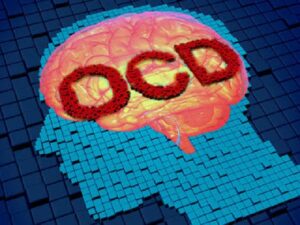Cognitive Behavioral Therapy is one of the most common treatments for OCD. It can be done in a therapist’s office, or it can be done at home with a therapist’s guidance. In this blog post, we will discuss how to do CBT at home for OCD. We will provide a step-by-step guide on how to get started, and we will also provide some helpful resources.
Contents
What Is OCD?

OCD is an acronym for Obsessive-Compulsive Disorder, a mental health condition that causes people to experience recurring thoughts and behaviors that interfere with their daily activities. People with OCD may obsessively think about certain topics or perform compulsive rituals, such as counting and checking items repeatedly. OCD can be a debilitating disorder, but it is treatable through Cognitive Behavioral Therapy (CBT).
What Is CBT?
Cognitive Behavioral Therapy (CBT) is a form of psychotherapy commonly used to treat anxiety disorders such as OCD. It focuses on changing the thought patterns and behaviors that are causing distress in an individual’s life. CBT helps build coping skills and introduces ways of thinking more positively by challenging negative beliefs and replacing them with healthier ones. This type of therapy is usually done with a trained therapist in an office setting, but it can also be done from home with the help of online or telephone counseling.
CBT At Home For OCD

Home treatment for OCD using CBT can provide individuals with the tools to manage their symptoms and improve their quality of life. Those who choose to pursue home treatment will work with a therapist remotely, typically through video chat software or phone calls.
During these sessions, the individual and their therapist will discuss techniques such as cognitive restructuring (changing negative thoughts into positive ones) and exposure and response prevention (exposing oneself to feared objects or situations while avoiding compulsive behaviors).
The goal of home treatment for OCD is to help individuals become better equipped to handle their symptoms independently and reduce the severity of their reactions to triggering situations. Home treatment sessions usually involve guided practice with the therapist, building up a repertoire of techniques that can be employed when needed. The therapist may also provide education about how OCD works and how to manage it effectively.
To achieve successful in-home treatment for OCD, individuals should remain consistent with their therapy appointments. They need to actively engage in the process, take notes between sessions, and regularly apply the skills they learn during CBT sessions in real-life situations. It’s important to remember that learning new skills takes time and effort; but with proper dedication and practice, successful outcomes are attainable. With the right support and guidance, individuals can gain control over their OCD symptoms and live a more fulfilling life.
Why Do People Prefer CBT at Home For OCD?
People prefer cognitive behavioral therapy (CBT) at home for their OCD treatment because it allows them to receive the same quality of care they would in a professional setting, but in the comfort and familiarity of their own home. CBT is an evidence-based approach to mental health that helps individuals identify and modify patterns of thinking and behavior that contribute to anxiety, depression, and other mental health disorders. In particular, CBT can be effective in helping people with OCD overcome intrusive thoughts, avoid triggers, and manage compulsions more effectively.
When done through online sessions or over video chat services such as Skype or Zoom, CBT at home provides clients with the opportunity to talk about their experiences without fear of judgment. Additionally, this form of treatment requires less time and money than in-person therapy, making it a great option for those who cannot afford long-term treatment or have difficulty traveling to a therapist’s office.
It is important to note that CBT at home is not a substitute for professional treatment, and individuals should consult with a qualified mental health provider before starting any OCD treatment program. With the help of an experienced psychologist or therapist, clients can learn how to better manage their symptoms and incorporate the skills they learn through CBT into daily life. Once these skills are mastered, people can feel more empowered to take control of their OCD and lead healthier happier lives.
Is CBT at Home For OCD Effective?

The answer is a resounding yes! Cognitive Behavioral Therapy (CBT) is an evidence-based approach to treating OCD that can be applied in the home setting. CBT for OCD focuses on understanding how thoughts and behaviors impact emotions, patterns of thinking, and overall wellness. By identifying negative thought patterns and changing them, individuals with OCD can learn techniques to combat obsessions and compulsions.
The effectiveness of CBT at home for OCD has been demonstrated in multiple clinical trials. One study found that 70% of patients experienced significant improvements in OCD symptoms after completing a course of CBT at home. Additionally, the study concluded that these patients maintained their gains even six months later. Another recent meta-analysis showed that cognitive behavioral therapy was associated with highly significant reductions in obsessive-compulsive symptom severity over time.
CBT at home for OCD is not only effective, but it can also be cost-effective and accessibly available to those seeking treatment. Online CBT programs provide individuals with access to evidence-based treatments from the comfort of their own homes, allowing them to receive personalized care on their schedule without having to travel or take time off work. Furthermore, research has found that online CBT can be more cost-effective than in-person treatment.
CBT at home for OCD is a safe and effective approach to managing the symptoms of this disorder. It can help individuals recognize patterns of thinking that are problematic and develop strategies to disrupt them. With the right support, individuals with OCD can take control of their condition and live healthier, happier lives.
What Are the Benefits of CBT at Home For OCD?
CBT at home for OCD has been proven to be an effective form of mental health care for people with OCD. People who use this type of therapy often report significant improvements in overall functioning, reduced anxiety and depression symptoms, fewer intrusive thoughts and compulsions, and better insight into their condition.
Some of these benefits are because CBT is a talk-based form of therapy. This means that you can discuss problems with your therapist and learn more about why you think, feel, and act in certain ways. You can also begin identifying triggers for your OCD behaviors so that you are better able to manage them in the future.
In addition, CBT at home for OCD offers a safe space for people to practice new skills within a supportive environment. Through this type of therapy, individuals can learn various methods of managing their symptoms, such as cognitive restructuring (changing how we think about situations) and relaxation techniques (such as mindfulness meditation). They will also be guided through exposure and response prevention (ERP) exercises which provide incremental steps toward tackling distressing situations.
Finally, CBT at home for OCD allows people to practice what they have learned in their own time and on their terms. This means that they can develop new skills more quickly and effectively while also gaining a better understanding of their condition. As a result, people are often able to improve their self-esteem and quality of life over time.
Overall, CBT at home for OCD is an effective form of mental health care that can help individuals gain insight into their condition, manage symptoms, and live fuller lives. With the support of a qualified therapist as well as consistent practice in between sessions, you too may experience these benefits from this type of therapy.
Are There Any Limitations of CBT at Home For OCD?

The answer is yes, there may be some limitations to cognitive behavioral therapy (CBT) at home for OCD. These limitations depend on the severity of symptoms, as well as the individual’s ability to follow through with treatment guidelines.
For those who can manage their own CBT program, they may eventually reach a point where further gains become more difficult and progress slows down. Additionally, self-directed CBT may not be appropriate for individuals whose OCD symptoms are severe or disabling. In this instance, it would be best for them to seek professional help from a mental health provider who can tailor interventions specific to their needs.
CBT at home also does not provide adequate monitoring and support from a licensed clinician. This can be a disadvantage for individuals who need more guidance or accountability to stay on track with their treatment.
Overall, it is important to find the right balance between self-directed and professional help when treating OCD. If an individual can manage their own CBT program effectively, then they are likely to have success in managing their OCD symptoms.
Conclusion
CBT at Home for OCD is an effective treatment option for people with Obsessive-Compulsive Disorder. It allows individuals to take the necessary steps to control their symptoms in a safe and comfortable environment, while also incorporating cognitive behavioral strategies into their daily lives. CBT at Home for OCD is designed to help individuals recognize and challenge negative thought patterns, as well as gain insight into their behavior and actions. With this treatment option, patients can take control of their mental health, leading them toward improved quality of life. Ultimately, CBT at Home for OCD offers individuals the opportunity to successfully manage their disorder and improve overall functioning.
For more information and guidance, please contact OCDMantra. OCD is a mental health disorder characterized by obsessions and compulsions. If you have any queries regarding OCD treatment, ERP therapy experienced therapists at OCDMantra can help: Book a trial OD therapy session.


